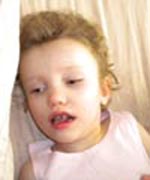Evangelina Sharashkina - Batten disease( Russia ) Posted on May 25, 2009
 Name: Evangelina Sharashkina
Name: Evangelina Sharashkina
Sex: Female
Country: Russia
Age: 6
Diagnosis: Batten disease
Beginning of treatment: April 4th, 2009
Medical history:
2 years ago, at 16 months old, the patient was diagnosed with pneumonia, had a fever, and paroxysmal limbs. Her condition improved after anti-inflammatory treatment and the tremors disappeared. A month later, the patient's reaction capacity gradually dropped. Patient suffered from seizures, movement, language and cognition functions worsened. Patient's immunity was low, and developed an infection. After the infection, her condition significantly worsened. The time period of her epileptic seizures decreased after taking VPA. Patient increased the amount of Kaplan and her seizures were controlled. However, her dyskinesia, speech disorder and cognitive disorder become more serious. Her condition was unstable and was related to her quality of sleep and the weather. She was diagnosed with NCL2 (Batten's disease) in 2008. The diagnosis was confirmed on February 15th, 2009 by the Enzyme Array (TTP test) in Seattle's Children's Hospital (USA).
When she was born, she suffered from congenital heart disease - Fallot's tetrad, and underwent heart surgery respectively in 2005 and 2007.
Before treatment:
She was very thin and her weight was 14kg. She could not stand up, crawl, or sit up or keep her back straight. It was difficult for her to hold her head up. The movement of her right arm and hand was impaired and therefore she couldn't clutch objects well, this was more obvious with regards to her right hand. Her speech was little more than babbling. She could chew or swallow pureed food but frequently had trouble swallowing liquids. She could drink some water only in the morning. She experienced both good and bad days. During her bad days, her appetite, swallowing, and ability to get sleep, was very poor and she had bad reactions. She often cried, screamed, and had poor responses to external stimulus. Her parents noticed that she frequently ached at night, and gave her medicine often.
Admission PE: The patient was fidgety; she had a bruise in the precordia region (approximately palm sized in scope). Whole systolic bilateral blowing murmur was 4 level, debilitating movement throughout the entire body; her extremities showed the most limited movement. Babinski signs in both lower limbs were positive.
Treatment: Doctors gave her complete neural stem cell therapy, including 4 stem cell injections.
After treatment:
After the treatment her condition was stable, and her weight was 15kg. She remained happy and talkative throughout the day. She was smiling when we praised her for her cuteness. She now sleeps well, has a more positive mood, her screaming and crying has mostly stopped and her appetite is very good (she always feels hungry; she ate 1000g per day previously, compared to 1800g per day now). She also drinks more than before (about 500ml per day previously, compared to 1000ml per day now). She now cries only when she is hungry or thirsty. She can hold a spoon in her right hand. When we help her sit up, she can hold her head up for more than one minute. Both hands can clutch things. The movement in her entire body is noticeably better, much less debilitating than before. She has slight bruising in the precordia region, approximately 1/5 palm sized (1cm*6cm). Whole systolic bilateral blowing murmur is 3 level.
The second round of treatment:
Admission Date: 2012-02-28
Days Admitted to Hospital: 22
Before treatment
Admission PE:
Evangelina received treatment at our hospital 3 years ago and when she was admitted to our medical center recently for the second round of treatment, her sleep quality had improved. She was able to sleep 7 hours per night. Her emotional expressions have improved and she can express sadness or joy. The involuntary movements throughout the body have noticeably decreased. The muscle strength throughout the body has increased. The muscle tone throughout the body is normal. Evangelina is able to raise her head up while lying on her back. Her appetite has increased. She still has speech difficulties and it is difficult for her to be understood by others. After she was initially discharged from our hospital 3 years ago she regularly took anti-epileptic medication for 3 months and then was taken off the medication. There were no epileptic seizures for about two years, but then about 1 year ago she started experiencing the seizures again and they gradually became more frequent. Despite taking antiepileptic medication regularly again, the seizures increased and her movement ability gradually decreased. She experienced muscle spasms throughout her body and was unable to eat solid food and had to be put on an all liquid diet which led to noticeable weight loss. During this time, the epileptic seizures were occurring weekly. Evangelina was unable to communicate at all and she was unable to move her body, except for bending her knees.
Treatment:
Evangelina received all of the relevant examinations. She was given medication in order to improve the blood circulation, autologous stem cell treatment and anti-epileptic medication. This was combined with physical rehabilitation training.
After the second round of stem cell treatment was completed, the epileptic seizures had been reduced, and the swallowing ability had improved. The control over the movements of the neck had noticeably improved.
Three weeks after Eva returned to her home in Moscow, her father wrote to tell us that she has been getting stronger, continually improving and doing quite well. Her crying has stopped and she is sleeping and eating better. She is even trying to get up on her own.
